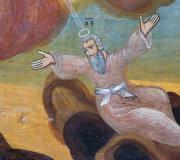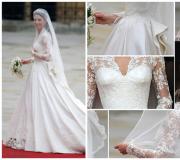Didactic game what grows on the Christmas tree target. Development of New Year's games for primary school children
▫ Touching bouquet!)) Thank you Galina Ivanovna!
▫ It rained continuously for two days. Today the sky is clear, the sun is shining))
▫ `To be loved, to love is wonderful!` Thank you, Vladimir Nikolaevich, for this call)) I want to continue and say a few words specifically about love. The wives of the Decembrists went into exile with their husbands. Among them were women who passionately loved their husbands and simply saw no other choice for themselves. This is Trubetskaya, Muravyova, but Volkonskaya found herself in a different situation. She was married off as a young girl to a man old enough to be her father. And she, as can be seen from her notes, in general, did not love him, did not love him with real love, which everyone assumes is necessary for marriage. But, nevertheless, when the question arose before her: to go or not to go, she went, as she herself writes, because there was a sense of duty, because she was his wife, they got married in church. She tried to love and hoped that the birth of a child would bring this love. Moreover, she simply did not have time to create love. They had only been together for a short time, and she had not been able to get to know her husband well. An uprising occurred. We all watched on the screen and read in books how she arrived, fell to her knees, and kissed his shackles. His suffering brought them closer. The example is very vivid and eloquent. Of course, it probably has some kind of exclusivity, because not everyone is exiled. Perhaps, indeed, in exceptional circumstances, such a sense of duty awakens in people, which turns out to be the strongest, and it seems to entail the birth of love or an increase in love. And in those cases when nothing extraordinary happens, when people simply live and work and a mutually unpleasant situation arises, what to do then? I think that relationships still need to be built. Decide for yourself: no matter what, there are no other options and there will never be any more, it is already forbidden to dream, since you have connected your life with this person. Sometimes they forget about this unity, that it is a person’s calling. And family is precisely the first step towards such unity. Where husband and wife are truly one flesh. After all, the ideal of love is when two people already become one. And it is precisely the family that is the organism in which two individuals, who were initially strangers to each other, must become a single whole with a single heart, single thoughts, without losing their personal uniqueness, but enriching and complementing each other. This harmonious whole is the most beautiful thing that can be in the world. And when children are included in the family, the flower blooms with more and more petals, and each of them makes the whole flower even more beautiful. And this makes all of humanity more beautiful when everything consists of such bouquets of flowers. 6446116-a3974049 Perhaps it turned out pathetic ((, but I really wanted to confirm your thoughts in your wonderful poems, Vladimir Nikolaevich. Thank you for the wonderful lines!!!
Game "What grows in the garden"
Didactic task. Learn to distinguish vegetables by taste and appearance.
Game task. Guess what vegetables the hedgehog put in the soup.
Game rule. Take out vegetables and determine their taste by looking at their appearance and touch.
Progress of the game
The teacher brings a hedgehog to the group and says: “The hedgehog grew a crop of vegetables in his garden. Hedgehog is a good cook. He decided to make soup. He cut the vegetables, put them in a pan, and then he got a phone call and he was distracted. When the hedgehog returned, he could not remember what vegetables he was cutting on the board. Help the hedgehog identify the vegetables for the soup."
The teacher gives the children to try chopped vegetables: carrots, cabbage, turnips. Vegetables can be placed in a deep cup so that children can take the vegetable without seeing it, touch it, and taste it.
Game "On our site"
Didactic task. Teach children to navigate the kindergarten area, name familiar objects, and run errands.
Game task. Introduce the hedgehog to the kindergarten area.
Game rule. Do not confuse the names of objects; come up with an assignment (at the teacher’s prompt).
The game is played while walking.
The teacher “notices” a hedgehog (toy) near the veranda and informs the children about it. The guys surround the hedgehog and examine it.
The teacher asks the children to introduce the hedgehog to the area and show all the most interesting things around. Children take turns taking the hedgehog and showing him everything they want, naming the object: veranda, slide, sandbox, ladder, swing, etc. The hedgehog gives the children instructions: move the bucket from the sandbox to the veranda, swing the doll on the swing; train the bear on the crossbar, dig the sand with a shovel and make a Easter cake. He asks the children to give him instructions too. At the end of the game, the hedgehog gives the children several apples, which the teacher treats them to for an afternoon snack.
Game "Who's behind the Christmas tree"
Didactic task. Teach children to name animals and highlight their characteristic features.
Game task. Guess what animals came to celebrate the New Year.
Game rule. Animals will not show up if they are named incorrectly.
The teacher shows the children a drawing that depicts a tree with the tails of animals protruding from behind it: a fox, a hare, a wolf. He reports that the animals came to the tree to celebrate the New Year and began to discuss what gifts Santa Claus had prepared for them. The animals hid behind the Christmas tree and argue about what gifts they will have. The teacher asks the children to guess who is hiding behind the tree.
The children, together with the teacher, reason and discover that animals can be recognized by their tails. In previous lessons, the kids have already become acquainted with these animals and learned their main features: who has a short tail, who has a long and fluffy tail, etc. Children guess the hidden animals and name them. If the animal is guessed correctly, then it “comes out” from behind the tree (the teacher puts the toy on the table) and greets the children.
Day four: Didactic games. “Assemble the Christmas tree” (puzzles), “The third wheel”,
“Find the tallest Christmas tree”, “Let’s make beads for the Christmas tree”
Didactic games.
“Assemble the Christmas tree” (puzzles), “The third wheel”, “Find the tallest Christmas tree",
“Let’s make beads for the Christmas tree.”
Integration of educational areas: “Cognition” (sensory culture), “Communication”, “Socialization”, “Artistic creativity”.
Types of children's activities: communicative, labor, cognitive and research, productive, artistic.
Goals of the teacher: learn to compare objects by length, height; develop attention, perseverance, creative imagination, fine motor skills
Materials and equipment: educational games, colored strips (short and long), glue.
Content of organizational activities children.
1. Organizational moment.
Children look at pictures with New Year's themes located oneasel.
Questions:
What holiday is coming soon?
What do you decorate before the New Year?
Who comes to the children on this holiday?
2. Didactic games.
Educator: “Guys, the New Year holiday is coming soon. The time when Santa Claus brings gifts, and the main beauty in the house isChristmas tree I suggest you today to sort through the pictures so that on themNew Year trees definitely appeared.”
Didactic game “Assemble the Christmas tree” (puzzles).
Two children assemble Christmas trees from individual geometric figures.They are compared by height.
Didactic game "The Third Wheel"
Educator: “I suggest you look carefully at the pictures located on the board (spruce, pine, autumn tree (rowan))
What do you think, children, which picture is the odd one out here? Why? (Rowan. Because this tree does not have needles or cones, and in the fall its leaves fall off. Pine and spruce never shed their needles).
Didactic game “Find the tallest Christmas tree”
Educator: “Look at all the pictures and find which one of themthe tallest Christmas tree."
Didactic game “Let’s make beads for the Christmas tree”
Educator: “I suggest, kids, to make beautiful beads for the Christmas tree, which will definitely come to us soon. (I am demonstrating a pre-prepared part of these beads from the same paper.) On the table you have short and long multi-colored stripes. From strips with gluewe glue the rings, first from short strips, small ones, then fromlong stripes, large rings. We connect the rings to each other,"alternating.
So we got beautiful New Year's beads with which we will decorate ourChristmas tree for the New Year.
3. Reflection.
Educator:
That's how great we played.
What games did you play?
What New Year's toy will we decorate our Christmas tree for the New Year?(Beads)
The ability to name the characteristic features of spruce, the signs that distinguish it from artificial spruce.
To formulate to see the differences between a toy spruce and a real one, to understand that spruce is a beautiful and useful tree.
Practice selecting adjectives.
Speech, thinking, imagination.
Fix the names of the numbers, be able to arrange them in reverse order.
Develop interest in theatrical play by actively involving children in play activities.
Develop the ability to feel free in a role.
Develop interest in the educational material of environmental fairy tales and stories.
Foster a caring and caring attitude towards living nature.
Progress of the lesson
I'm asking a riddle:
It's getting cold.
The whole earth was covered with a white blanket.
A blizzard is walking in the field,
When does this happen?
What is the most beautiful, wonderful, magical holiday that happens in winter?
New Year is a favorite holiday all over the world. Why?
(Father Frost and Snow Maiden come and bring gifts...)
Poem reading:
New Year! New Year!
At the door, at the gate!
He came to you, to me
And to the whole big country!
The custom of celebrating the New Year appeared in Russia 300 years ago, when Tsar Peter I, by his decree, established a single day for celebrating the New Year on the night of December 31 to January 1. Peter I ordered all residents of Moscow to celebrate the New Year with celebrations: decorate their houses with fir trees, give each other New Year's gifts.
In some countries, children on New Year's Eve were visited not by Santa Claus, but by his brother Santa Claus. In Germany, he rides around on a donkey and leaves gifts in children's shoes.
In India, the New Year is celebrated not in winter, but at the beginning of summer. Children collect dry branches and straw, and light fires at night. Children, adults, and even old people sing and dance around them.
Not all nations start the New Year on January 1st. In different countries, the New Year does not begin at the same time; in some - in early summer, in others - in autumn or spring.
And New Year's surprises in different countries are presented by a variety of wizards. But they all wish peace, health and happiness.
Looking at the painting “New Year”
What are the children doing?
How do you prepare for the New Year? (decorated the Christmas tree with colorful toys: balls, beads, garlands...)
Listen to who this New Year's riddle is about:
He looked into the well -
The well was covered with ice.
And I looked at the river -
Dressed in an ice sheepskin coat.
He has a gray beard,
Fur coat. Staff with a star,
He brought us gifts
Good... (Grandfather Frost)
How are you preparing for the New Year? (we learn songs, poems, round dances...)
How do people congratulate each other on New Year's Day? (give gifts, send postcards, parcels, letters...)
Do you love New Year? Why do you love New Year?
Reading the poem by N. Grigorieva “Why do I love the New Year?”
Why do I love New Year?
Of course - for the Christmas tree,
For slippery and shiny ice,
For clean air it’s bitter.
Also for what's on the glass
Magic patterns
Sometimes they remind me
Forests, palaces and mountains.
I love it because even in the cold
It's hot for me to play in the snow
Also because Santa Claus
He brings gifts to our house.
Garlands of light bulbs around
Flashing in different colors,
And even adults all of a sudden
They become like children.
And home life is surrounded
Care and attention.
And the spread table is set
With special effort.
And I know they won’t send me to sleep,
Until the chimes strike,
And on this night there are always fireworks,
And laughter and musicians.
And Happy New Year I don't mind
Walk in a merry march,
It's no secret that on this night
I'm getting older.
What is the main decoration of the New Year's holiday? (Christmas tree)
Mystery:
I come with gifts
I shine with bright lights,
Elegant, funny,
I'm in charge for the New Year.
(Christmas tree)
Didactic game “What kind of New Year tree?”
(festive, shiny, beautiful, fluffy, green, fragrant, elegant, funny, prickly, slender, tall, main...)
Didactic game “What does the New Year Tree do for us?”
(sparkles, burns, shines, cheers, stands, pleases, smells fragrant, dresses up...)
What is the difference between a spruce and an artificial tree?
(spruce grows in the forest, and an artificial tree is made at a factory; cones grow on spruce, but cones do not grow on an artificial tree; spruce smells of pine needles, resin, but the artificial tree does not smell; spruce feeds birds and animals with the seeds of cones, but the artificial tree feeds no one does not feed; spruce gives healing air; musical instruments are made from spruce wood...)
Game What grows on the Christmas tree?
If you agree, raise your hands up and say: “Yes!” And if you don’t agree, then remain silent and don’t raise your hands.
– What grows on the Christmas tree?
Bunnies made of cotton wool? – Yes!
– Chocolate bars?
- Yes!
– Cribs?
- No!
– What grows on the Christmas tree?
Beads?
- Yes!
- Firecrackers?
- YES!
- Old pillows?
- No!
– What grows on the Christmas tree?
Vibrant pictures?
- Yes!
- White snowflakes?
- Yes!
- Torn shoes?
-No!
What can two girlfriends talk about if they meet: a spruce tree standing under the snow in the forest and a decorated Christmas tree at home that was cut down.
I was born in the forest
I always grow in the forest,
Slim in winter and summer
I'm standing green.
The snowstorm sings songs to me
- Sleep, Christmas tree, bye-bye,
Snow covers the branches
- Look, don't freeze.
Gray bunny coward
Sitting under the Christmas tree.
Sometimes a wolf, an angry wolf
He's watching the bunny.
And the fluffy squirrel
He sits in my hollow,
And feast on pine cones
He sleeps here with the baby squirrels.
And have fun with your friends
I should stand here in the forest.
2. I also grew up on the edge of the forest,
Next to you, girlfriend.
And I really dreamed
Oh, how I dreamed
Get to the guys in the New Year!
And then one day, passing by on a sleigh,
He noticed me and took me with him,
For the holiday they put me in the hall
Decorated with beads and tinsel.
Oh, how lovely it was there!
Oh, how wonderful it was there!
But it all ended after a noisy ball,
I'm lying in a ravine, no one needs me.
I've turned yellow and fallen
And now I’m dying, what a disaster!
Why waste it in vain?
Green this beauty.
I was so beautiful
In a winter white forest.
What happened to the Christmas tree that was cut down?





Tkachenko Larisa Petrovna
Didactic game« Logical tree»
Target: develop children's sensory abilities, logical thinking, observation. Exercise the ability to choose the necessary one from a variety of shapes, classifying them by color and shape.
Equipment: didactic manual« Logical tree» with multi-colored branches and frames for geometric shapes, geometric shapes - inserts of different colors.
Progress of the game.
Educator: Guys, we have a new girl in our group Christmas tree. Why do you think?
Children: New Years is soon.
Educator: Correct, but ours unusual tree. (Showing) Look how unhappy she is, is there something missing here?
Children: Toys.
Educator: Of course there are toys, but here is a box of toys, let's look at them. Is not Children: just Christmas decorations, but what are they?
Children: Geometric figures.

Educator: Let's decorate our Christmas tree. Please note that each branch on the Christmas tree has its own color, and the color of the toy must match the color of the branch. (Children take turns taking a geometric figure toy and hanging it on the Christmas tree.) I ask questions:

What geometric shape is this toy?
What color is the square?
What color branch will you hang this circle on?
When the toys are all in place, I suggest you admire the decorated Christmas tree, how it came to life, how beautiful it is, let’s sum it up. You can draw the same Christmas tree on paper as a free activity. (improvisation, creativity and imagination are possible.)





